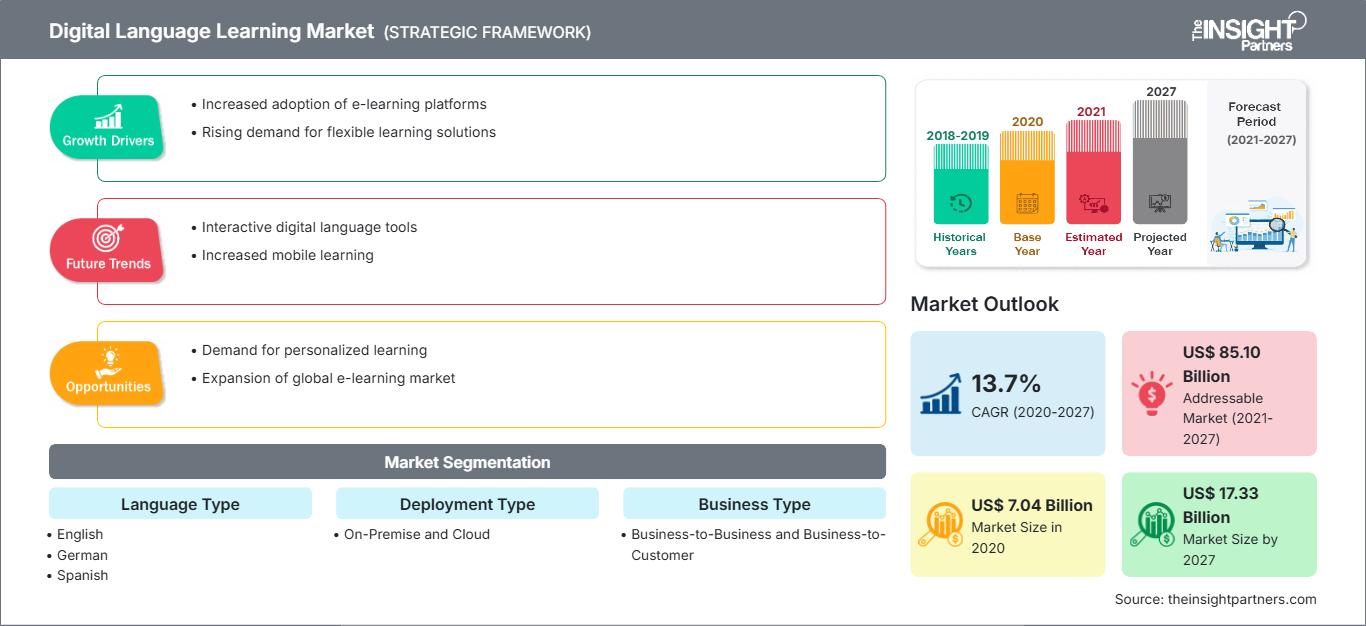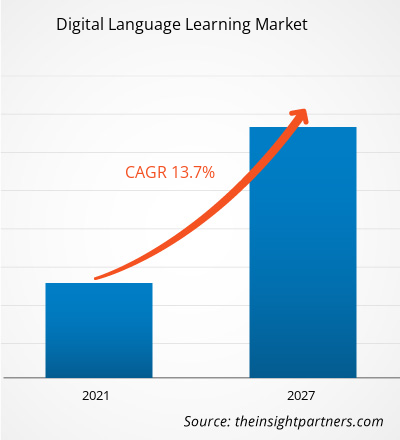预计数字语言学习市场将从 2020 年的 70.382 亿美元增长到 2027 年的 173.334 亿美元;预计 2020 年至 2027 年的复合年增长率为 13.7%。
各国政府实施英语语言学习计划的举措促进了市场的增长。在各国政府和私人组织为提供数字化增强绩效而采取的各种举措的支持下,全球教育行业正在发生指数级转变。中国、澳大利亚、巴西和阿联酋等各国政府在过去几年中都启动了数字教育计划,这有助于这些国家加强其英语教育体系。例如,澳大利亚政府十年前发起的数字教育革命 (DER) 使多所学校和大学能够利用数字教育。同样,中国政府也出台了多项政策,推动以英语学习为重点的数字教育发展,这推动了为中国学生提供数字学习解决方案的公司数量的增长。51Talk是中国最知名的数字英语学习机构之一;一起作业是另一个面向中国学生、教师和家长的数字平台,它以练习和家庭作业的形式提供在线作业,帮助最终用户提升自身能力。目前,印度正在加紧为数字教育创造巨大的市场空间。印度政府已采取各种举措,在教育领域推广数字化技术。SWAYAM是印度政府推出的最著名的数字学习平台和举措,它帮助学生选择涵盖所有高等教育科目的在线课程。国际大学也被允许通过SWAYAM平台提供各自的课程和考试,这方便学生学习和选择国际大学的考试。这提高了学生的英语学习、口语和写作能力。国家数字图书馆是印度政府实施的另一项举措,旨在通过一站式服务提供虚拟学习资源。这项举措正逐渐受到重视,预计将在未来几年推动印度数字英语学习市场的增长,从而促进全球数字语言学习市场的增长。
自定义此报告以满足您的要求
您将免费获得任何报告的定制,包括本报告的部分内容,或国家级分析、Excel 数据包,以及为初创企业和大学提供超值优惠和折扣
数字语言学习市场: 战略洞察

-
获取本报告的主要市场趋势。这个免费样本将包括数据分析,从市场趋势到估计和预测。
新冠疫情对数字语言学习市场的影响
最近几个月,全球爆发的疫情给现有的教育领域带来了显著的积极影响。此外,传统教育机构和课堂教学模式的颠覆,也促使人们越来越多地采用稳健高效的在线和数字学习解决方案,预计未来几年疫情过后,这些解决方案将继续推动市场增长。例如,联合国教科文组织与多位科技企业和国际电信联盟(ITU)的领军代表合作,强调了在学习中采用数字技术的经济意义,旨在帮助新兴经济体在无需大量投资实体基础设施的情况下,让更多受众获得快速学习的能力。而剑桥大学进行的另一项调查显示,超过1200名受访者表示,未来几年,60%的受访者表示,他们有更高的倾向继续使用数字学习技术。因此,最近的疫情爆发促进了数字学习技术应用的激增,并随后对过去几个月的市场增长产生了积极影响。
市场洞察——数字语言学习市场利用先进和简化的技术吸引学生接受数字教育
在美国和英国等发达国家,数字教育系统已经获得了极大的普及,因为学校、大学和其他机构的学生完全了解这些技术。然而,在亚太地区和南美地区国家,学生缺乏技术驱动学习的意识。一些学校、大学和辅导机构正在课堂上实施数字技术。随着数字教育平台开发商不断升级其技术以提供强大的解决方案,亚太地区的采用者也在不断升级其技术基础设施。创新的云端教育应用程序、网站和其他服务预计将为数字教育(包括数字语言学习解决方案)创造一个巨大的市场。
基于语言类型的洞察
根据语言类型,数字语言学习市场细分为英语、普通话、西班牙语、德语和其他语言。英语市场在 2019 年占据了最大的市场份额。数字语言学习市场区域洞察
The Insight Partners 的分析师已详尽阐述了预测期内影响数字语言学习市场的区域趋势和因素。本节还讨论了北美、欧洲、亚太地区、中东和非洲以及南美和中美洲的数字语言学习市场细分和地域分布。
数字语言学习市场报告范围
| 报告属性 | 细节 |
|---|---|
| 市场规模 2020 | US$ 7.04 Billion |
| 市场规模 2027 | US$ 17.33 Billion |
| 全球复合年增长率 (2020 - 2027) | 13.7% |
| 历史数据 | 2018-2019 |
| 预测期 | 2021-2027 |
| 涵盖的领域 |
By 语言类型
|
| 覆盖地区和国家 |
北美
|
| 市场领导者和主要公司简介 |
|
数字语言学习市场参与者密度:了解其对商业动态的影响
数字语言学习市场正在快速增长,这得益于终端用户需求的不断增长,而这些需求的驱动因素包括消费者偏好的演变、技术进步以及对产品优势的认知度的提升。随着需求的增长,企业正在扩展其产品线,不断创新以满足消费者需求,并抓住新兴趋势,从而进一步推动市场增长。

- 获取 数字语言学习市场 主要参与者概述
在数字语言学习市场运营的参与者主要专注于开发先进高效的产品。
- 2019 年,Fluenz 宣布将其西班牙语奢华沉浸式课程扩展到 2020 年春季的西班牙巴塞罗那。用户将能够参加为期六天的语言学习课程。
- 2018 年,Preply, Inc. 宣布计划于 2019 年初在巴塞罗那开设新办事处。此次扩张是 7 月份 400 万美元融资的结果。该公司进一步计划扩大其在德国、英国、美国和拉丁美洲市场的影响力。
数字语言学习市场细分如下:
全球数字语言学习市场 - 按语言类型
- 英语
- 德语
- 西班牙语
- 普通话
- 其他
全球数字语言学习市场 - 按部署类型
- 本地
- 云
全球数字语言学习市场 - 按业务类型
- 企业对企业
- 企业对客户
全球数字语言学习市场 - 按最终用户
- 学术
- 非学术
全球数字语言学习市场 -按地理位置
- 北美
- 美国
- 加拿大
- 墨西哥
- 欧洲
- 法国
- 德国
- 意大利
- 俄罗斯
- 英国
- 其他地区欧洲
- 亚太地区 (APAC)
- 日本
- 中国
- 澳大利亚
- 印度
- 韩国
- 亚太地区其他地区
- 中东和非洲 (MEA)
- 沙特阿拉伯
- 阿联酋
- 南部非洲
- 中东和非洲其他地区
- 南美洲 (SAM)
- 巴西
- 阿根廷
- 其他地区SAM
数字语言学习市场 – 公司简介
- Babbel
- Busuu, Ltd.
- Fluenz
- Lingoda GmbH
- Living Language (Penguin Random House, LLC)
- Pearson PLC
- Preply, Inc.
- Rosetta Stone, Inc.
- Verbling, Inc.
- Yabla, Inc.
- 历史分析(2 年)、基准年、预测(7 年)及复合年增长率
- PEST和SWOT分析
- 市场规模、价值/数量 - 全球、区域、国家
- 行业和竞争格局
- Excel 数据集
近期报告
相关报告
客户评价
购买理由
- 明智的决策
- 了解市场动态
- 竞争分析
- 客户洞察
- 市场预测
- 风险规避
- 战略规划
- 投资论证
- 识别新兴市场
- 优化营销策略
- 提升运营效率
- 顺应监管趋势






















 获取免费样品 - 数字语言学习市场
获取免费样品 - 数字语言学习市场